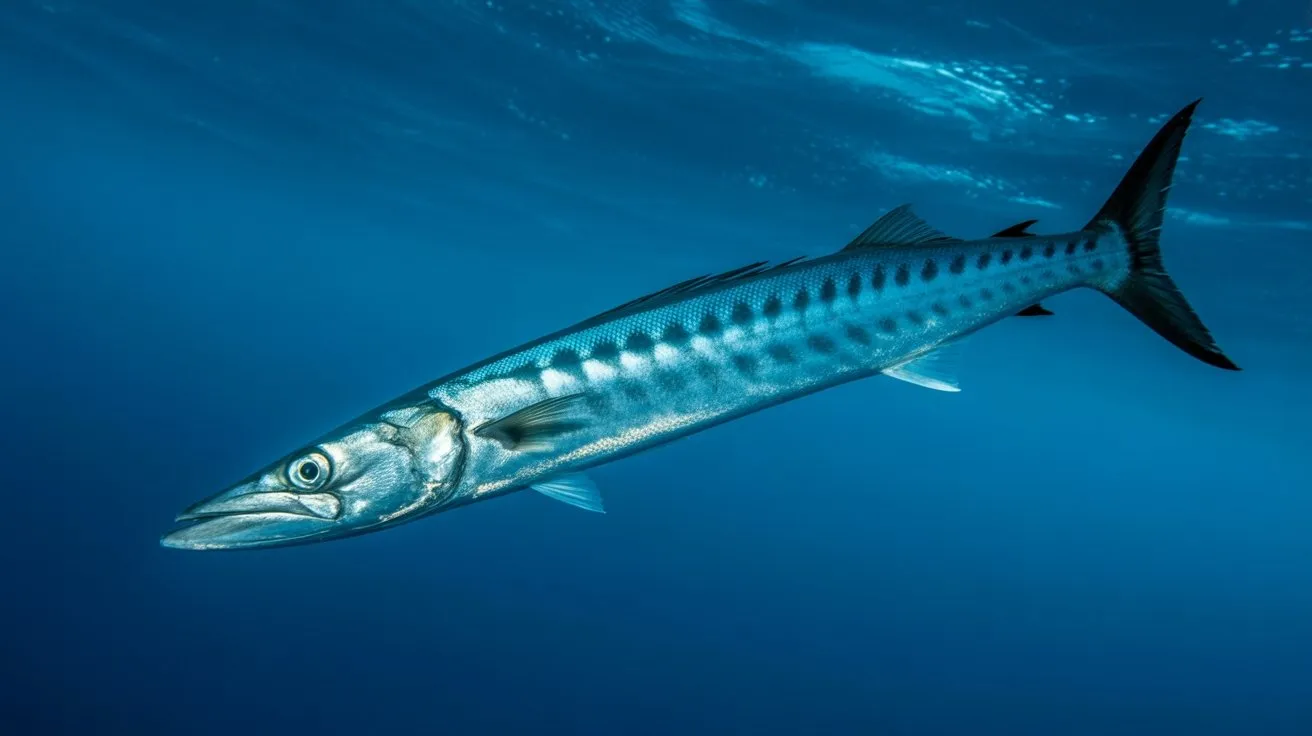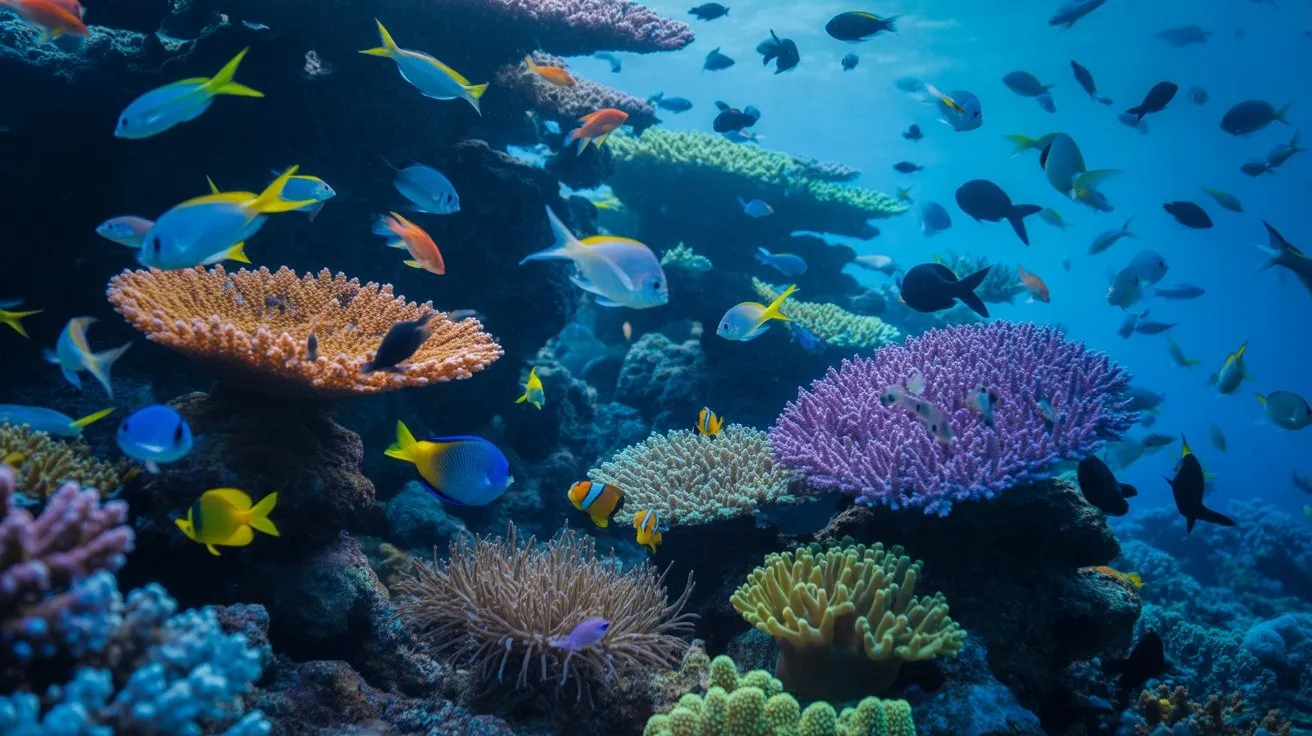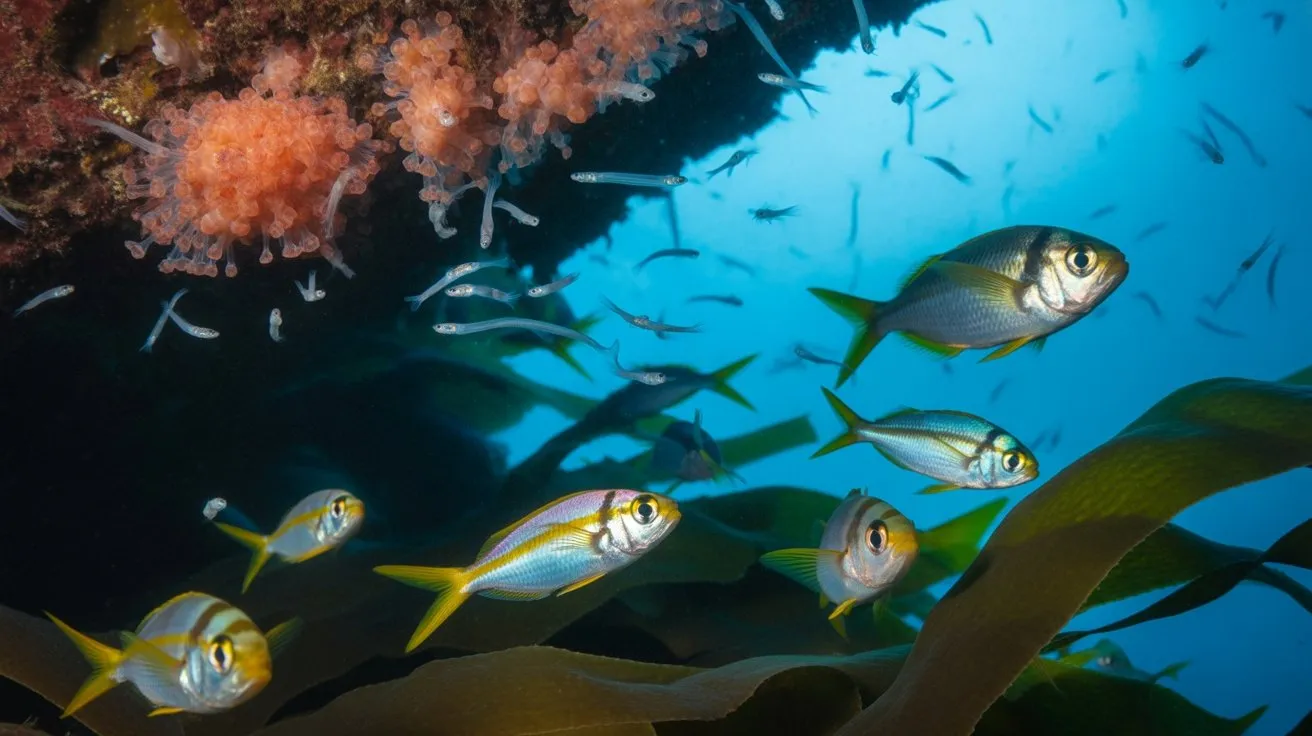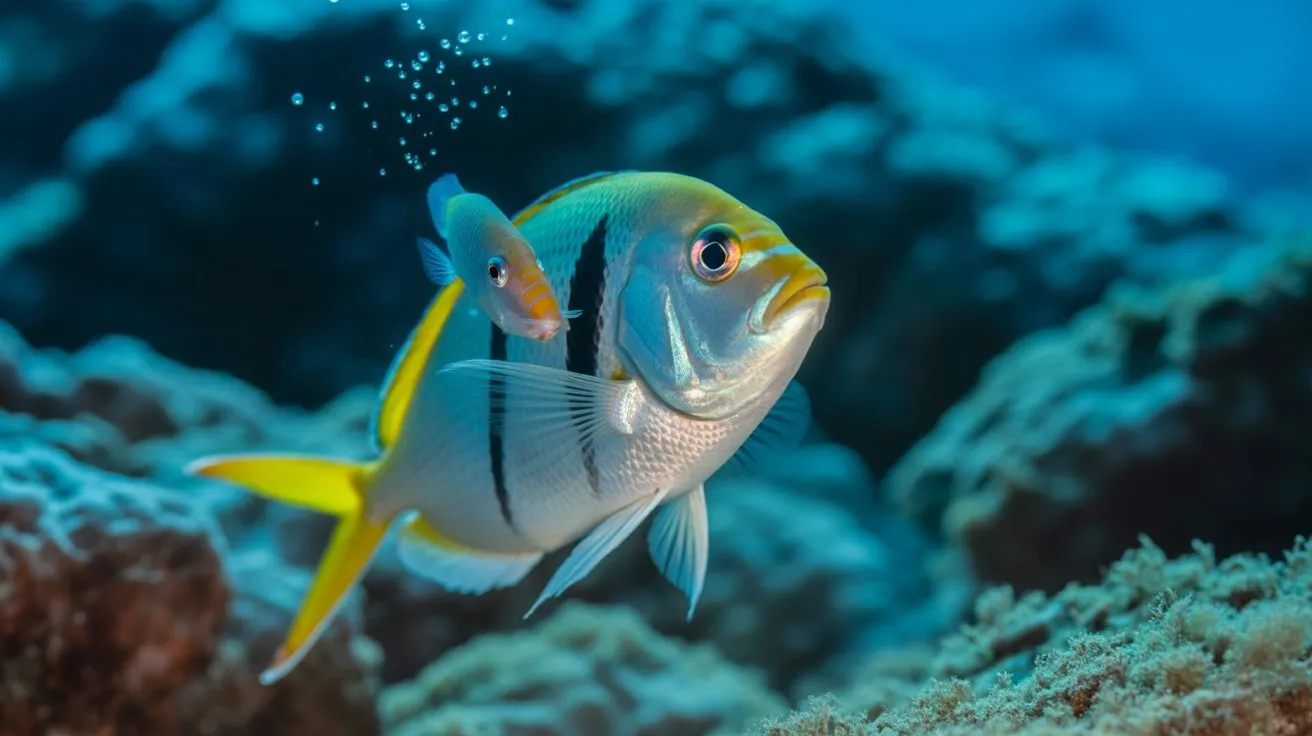You’ll find that barracuda can generate thrust forces exceeding 40 times their body weight during initial acceleration phases, propelling them to 35 mph in under three-tenths of a second. This biomechanical efficiency stems from their fusiform body design and specialized muscle fiber composition, creating what marine biologists consider nature’s most effective ambush predator. Yet their speed represents only half the equation—their precision targeting system operates through mechanisms that challenge our understanding of aquatic sensory integration.
Torpedo-Shaped Anatomy Built for Speed
Six key anatomical features enable barracudas to achieve remarkable swimming speeds of up to 36 miles per hour.
You’ll notice their streamlined fusiform body reduces drag coefficients by 40% compared to laterally compressed fish. Their caudal fin’s lunate design generates maximum thrust through high aspect ratio mechanics.
Large pectoral fins positioned anterior provide precise steering control during rapid directional changes. You’ll observe their muscular composition contains 65% fast-twitch fibers, enabling explosive acceleration bursts.
Their swim bladder maintains neutral buoyancy without energy expenditure, while specialized scales feature micro-ridges that create laminar flow patterns.
These adaptations collectively produce swimming efficiencies of 85%, making barracudas apex predators capable of pursuing prey at sustained speeds.
Lightning-Fast Attack Strategies and Hunting Techniques
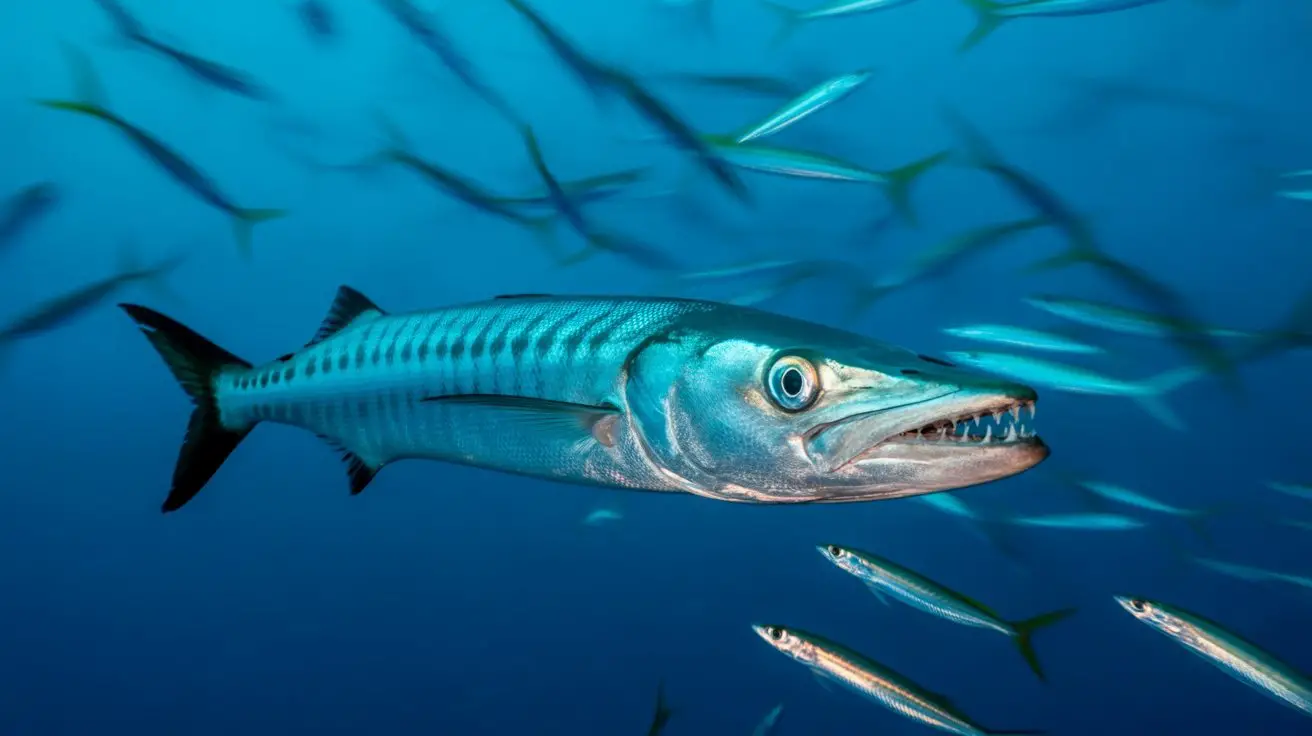
These anatomical adaptations translate into devastating predatory behaviors that position barracudas among the ocean’s most efficient hunters.
You’ll observe barracudas employing ambush tactics, accelerating from 0-35 mph in 0.3 seconds through rapid tail propulsion. They’ll position themselves near reef edges, drop-offs, or turbid waters where visibility decreases, maximizing strike success rates to 89%.
Their attack sequence involves three distinct phases: detection at 15-20 meters, positioning within 2-3 meters, and explosive acceleration covering the final distance in milliseconds.
You’ll notice they target prey’s anterior region, utilizing their razor-sharp teeth to deliver incapacitating bites. Post-strike, barracudas employ a “turn-and-swallow” technique, repositioning prey headfirst for ideal ingestion.
This calculated hunting methodology demonstrates remarkable energy efficiency, requiring minimal caloric expenditure per successful capture.
Razor-Sharp Teeth and Powerful Jaw Mechanics
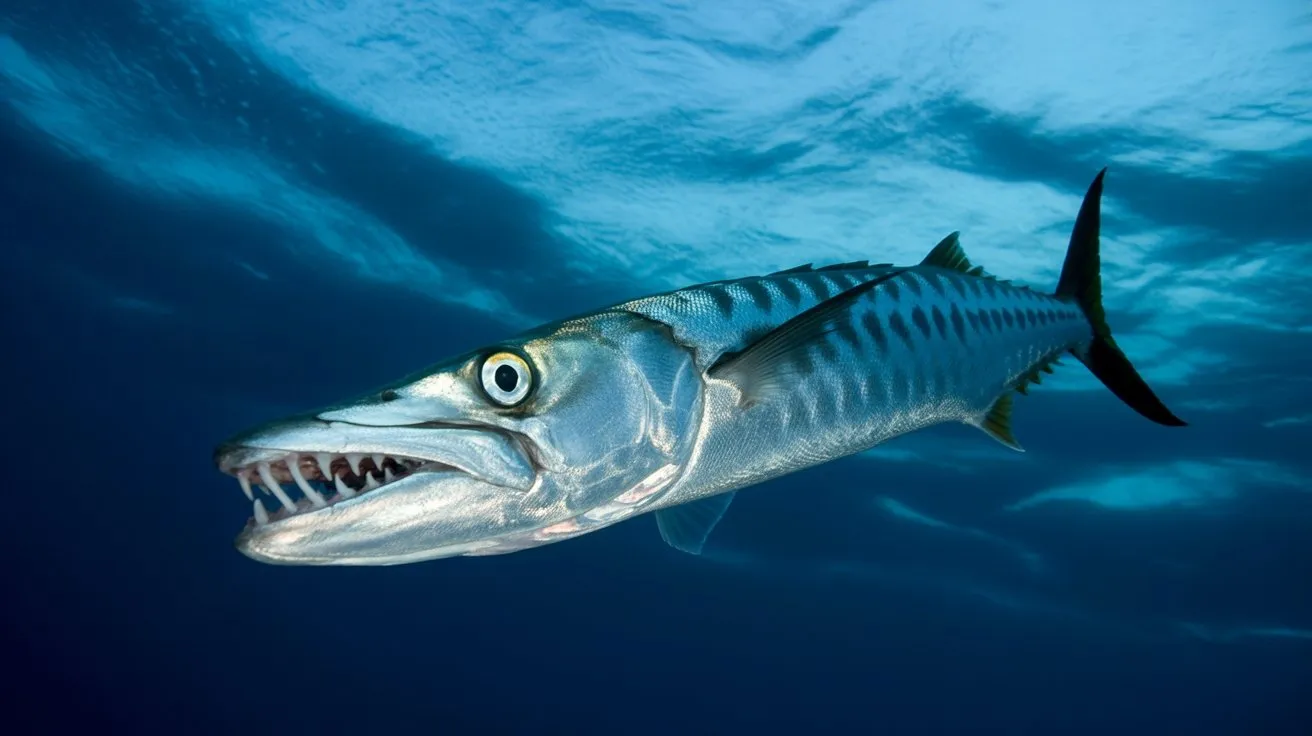
Barracudas possess dental weaponry comprising 18-20 fang-like teeth per jaw, each measuring 2-4 centimeters in length with serrated edges capable of exerting 30-40 pounds per square inch of pressure.
You’ll observe their mandibular structure features protrusible jaws extending forward during strikes, increasing reach by 15-20%. Their maxillary bones pivot independently, creating a scissor-like cutting mechanism that severs prey cleanly.
The pharyngeal teeth arrangement guarantees unidirectional food transport, preventing escape once captured. You can’t overlook their jaw muscles’ rapid contraction rate of 0.02 seconds, generating maximum force instantaneously.
Their tooth replacement occurs continuously throughout life, with new teeth emerging every 10-14 days. This biological engineering creates an efficient predatory system optimized for capturing fast-moving fish through precise mechanical advantage and sustained cutting capability.
Superior Vision and Sensory Systems
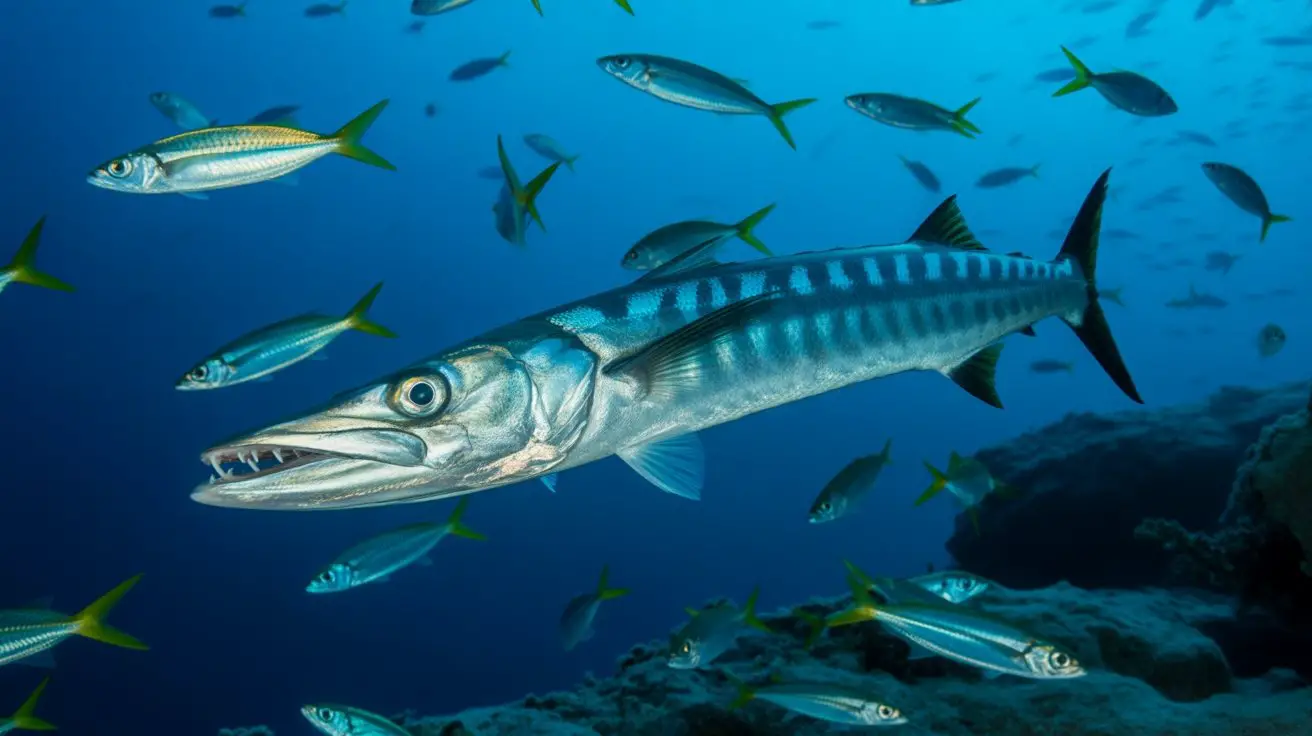
Exceptional visual acuity enables barracudas to detect movement from distances exceeding 100 meters, utilizing binocular vision with a 340-degree field of view that leaves minimal blind spots.
You’ll find their retinal structure contains specialized cone cells optimized for detecting polarized light patterns and rapid motion detection. Their tapetum lucidum reflects available light, maximizing photon capture in low-light conditions at depths reaching 200 meters.
Lateral line systems amplify their sensory capabilities through neuromasts detecting water displacement as subtle as 0.01 millimeters.
You’re observing mechanoreceptors that process hydrodynamic signatures from prey fish up to 30 meters away.
Chemoreceptors within their nostrils analyze dissolved compounds at concentrations below 10⁻⁹ molar, tracking prey scent trails across significant distances through turbulent water columns.
Geographic Distribution Across Tropical Waters
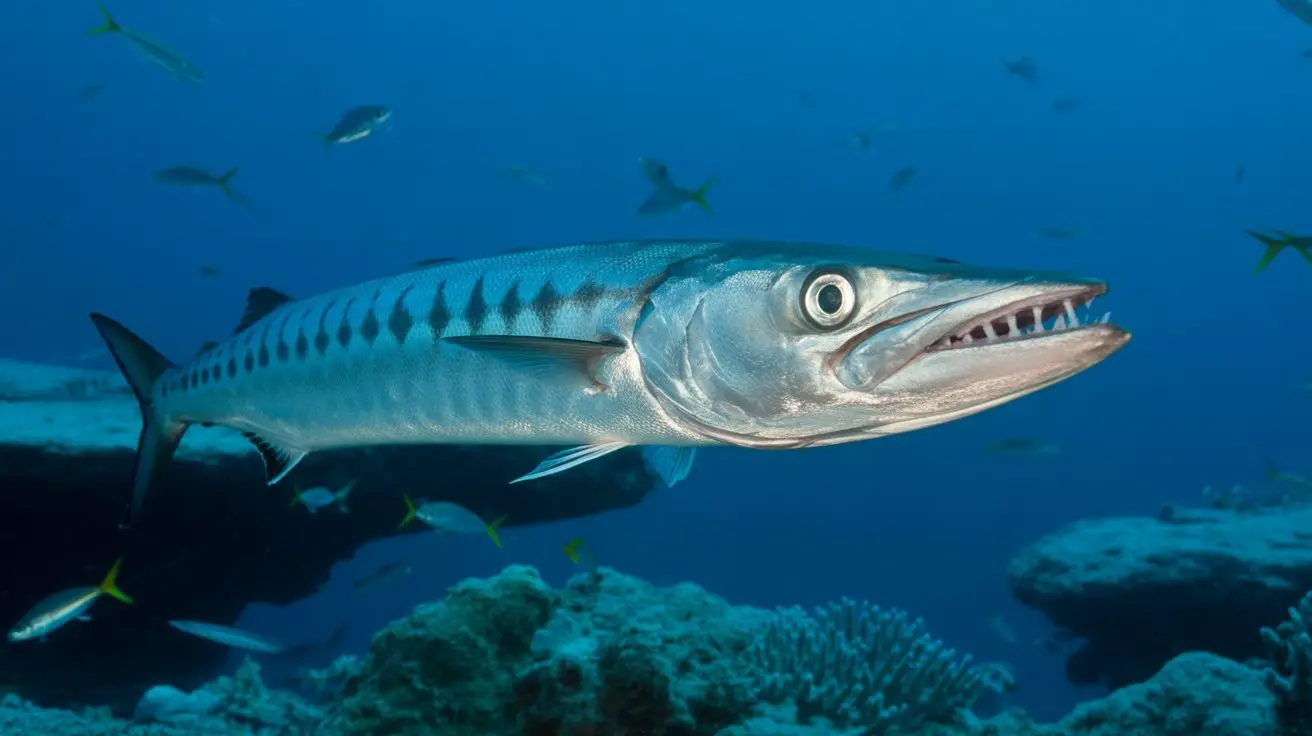
Spanning warm oceanic regions between 40°N and 40°S latitudes, over twenty barracuda species inhabit coastal and pelagic zones where water temperatures consistently exceed 20°C.
You’ll find great barracuda (Sphyraena barracuda) distributed throughout the Atlantic, Pacific, and Indian Oceans, preferring depths from surface waters to 100 meters. Caribbean populations demonstrate highest density concentrations, while Pacific variants occupy Hawaiian and Indo-Pacific reef systems.
You’ll observe species-specific habitat preferences: yellowtail barracuda favor deeper offshore waters, whereas pelican barracuda remain within 30-meter coastal zones.
Temperature gradients directly influence distribution patterns—you won’t encounter barracuda populations where thermoclines drop below 18°C.
Seasonal migrations follow warm current systems, with populations tracking isothermal boundaries northward during summer months and retreating toward equatorial regions when temperatures decline.
Prey Selection and Dietary Preferences
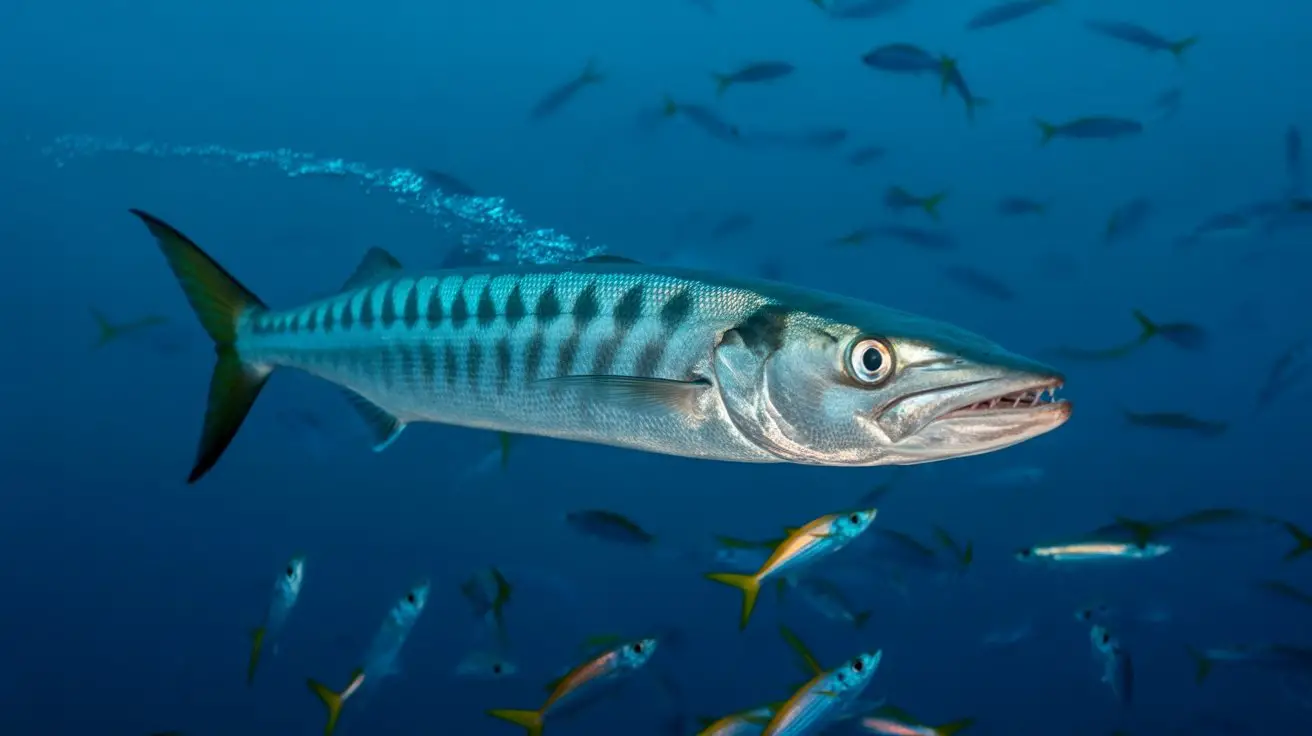
Driven by opportunistic hunting strategies, barracuda exhibit highly selective predation patterns targeting fish species measuring 10-25% of their own body length. You’ll observe their preference for schooling fish with high lipid content, maximizing energy acquisition while minimizing pursuit costs.
| Prey Species | Body Length (cm) | Frequency (%) |
|---|---|---|
| Sardines | 8-15 | 34 |
| Anchovies | 6-12 | 28 |
| Mullet | 12-20 | 22 |
| Small Jacks | 10-18 | 16 |
Their hunting parameters shift based on habitat zones. You’ll find juvenile barracuda targeting smaller prey like glass minnows and silversides in shallow waters, while adults focus on mid-water column species. They’re equipped with specialized dentition featuring razor-sharp canine teeth for piercing and smaller cutting teeth for processing, enabling efficient capture of fast-moving, silvery fish that constitute 85% of their diet.
Evolutionary Adaptations for Aquatic Dominance
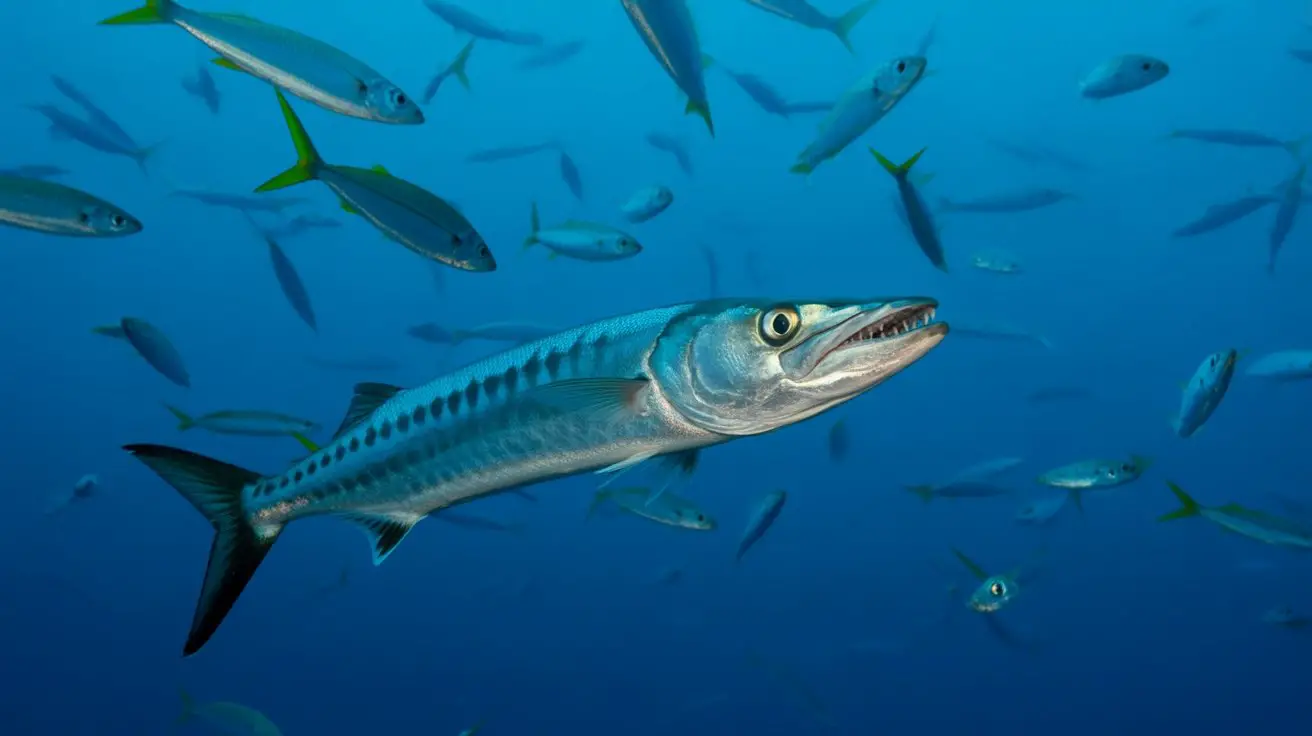
These highly specialized feeding behaviors stem from millions of years of morphological and physiological refinement that positioned barracuda as apex predators across tropical and subtropical marine ecosystems.
You’ll observe their streamlined fusiform body design reduces drag coefficients by 40% compared to generalist reef fish. Their caudal fin’s high aspect ratio generates thrust-to-drag ratios exceeding 8:1, enabling burst speeds reaching 58 km/h.
You’ll notice their enlarged red muscle fiber composition comprises 25% of total muscle mass—double that of similar-sized teleosts. Their gill raker modifications create laminar flow patterns that increase oxygen extraction efficiency by 35%.
These adaptations converge to produce hunting success rates of 85-92%, demonstrating how selective pressures sculpted barracuda into precision predatory machines optimized for pelagic environments.
Behavioral Patterns and Territorial Instincts
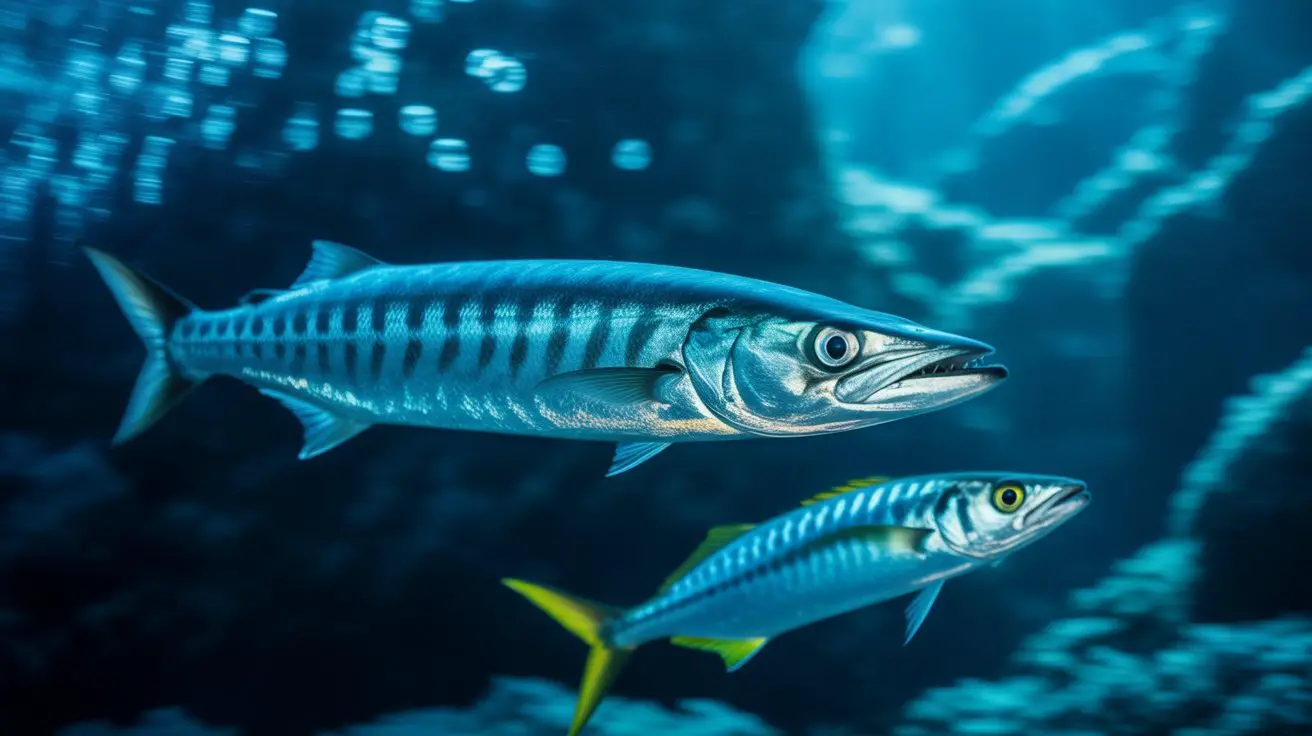
While their physical adaptations enable exceptional predatory performance, barracuda exhibit complex social hierarchies and territorial behaviors that further optimize their hunting efficiency. You’ll observe dominant individuals establishing feeding zones within reef systems, defending 200-500 square meter territories through aggressive posturing and rapid displacement maneuvers.
| Behavioral Pattern | Territory Size | Duration | Prey Success Rate | Social Structure |
|---|---|---|---|---|
| Solitary hunting | 300-500 m² | 6-8 hours | 78% | Individual dominance |
| Loose aggregation | 150-300 m² | 3-5 hours | 65% | Temporary hierarchy |
| Ambush positioning | 50-100 m² | 2-4 hours | 85% | Site-specific control |
| Patrol circuits | 400-800 m² | 8-12 hours | 72% | Sequential dominance |
| Feeding competition | Variable | 30-90 minutes | 45% | Contested hierarchy |
You’ll notice juveniles form schools for protection, while adults typically maintain territorial boundaries through visual displays and lateral positioning behaviors.
Conclusion
Can you imagine any predator more perfectly engineered for aquatic dominance than the barracuda? You’ve witnessed how its torpedo morphology, instantaneous 0-to-35-mph acceleration within 0.3 seconds, and sophisticated sensory arrays create an apex predator. You understand that its razor-sharp dentition, enhanced visual acuity, and refined lateral line mechanoreception systems represent millions of years of evolutionary optimization. You’re observing nature’s most efficient piscivorous hunter, demonstrating unmatched biomechanical precision across tropical marine ecosystems worldwide.
